SEX IN JAPAN

sex manga A survey by the Tokyo-based Japanese Association for Sex Education in 2006 found that 62 percent of female university students had had sex, up 10 percent from six years earlier, and around the same level as men. In the first survey by the group in 1974, 23 percent of male and 11 percent of female university students said they had sex.
A study in 2002, found that 46 percent of female high school seniors had had sex, compared to 10 percent in 1984, and 37 percent of male high school seniors had had sex, compared to 20 percent in 1984. Another study found that 40 percent of high school students that have sex use condoms when they do and they change sexual partners frequently.
There are Shinto shrines in Japan, where pregnant women can offer radishes in hopes of achieving sexual gratification. Some Shinto temples have sex museums.
The “ Dosjin Festival “, held in Matsumoto in late September, is better known as the “phallus festival.”Held at the Utsukushigahara Onsen it is named for a pair of deities called 'dosojin' that can be found on stone statues in this region. During the festival women dress up in costumes of giant penises and walk through the streets while wild merry making goes on.
Websites and Resources
Links in this Website: SEX IN JAPAN Factsanddetails.com/Japan ; PROSTITUTES, SEX CLUBS AND SEX INDUSTRY IN JAPAN Factsanddetails.com/Japan ; HOSTESSES, HOSTS AND STRIPTEASE IN JAPAN Factsanddetails.com/Japan ; SEX, CHILDREN, TEACHERS AND SUBWAYS IN JAPAN Factsanddetails.com/Japan ; SEX, DATING CLUBS AND SCHOOLGIRLS IN JAPAN Factsanddetails.com/Japan ; HOMOSEXUALITY IN JAPAN Factsanddetails.com/Japan
Books: “The Japanese Art of Sex: How to Tease, Seduce and Pleasure the Samurai in Your Bedroom” by Jina Bacarr (Stone Bridge Press, 2004); “Tabloid Tokyo” by Geoff Botting, Ryann Connell, Michael Hoffman and Mark Schreiber (Kodansha, 2005); “The Japanese Disease” by Declan Hayes (iUniverse, 2005). Good Websites and Sources: Sex Articles on Japan for the Uninvited japanfortheuninvited.com ; Love Hotels quirkyjapan.or ; Bookmice article on Sex in Japan bookmice.net ; Underwear Theft in Japan japanvisitor.com ; Panty Theft Raid wordpress.tokyotimes.org ; Japanese Legends About Supernatural Sweethearts pitt.edu/~dash/japanlove

Sex Industry in Japan Pink Box, Inside Japan’s Sex Industry pinkboxjapan.com ; You Tube Video of Tokyo Sex Club Tour YouTube ; Wikipedia article on Prostitution in Japan Wikipedia ; Brothels in Osaka on 21 or Over,com 21orover.com ; Japan Times article on Osaka Brothels Japan Times
Sex Trafficking Video International Labor Organization ; Kabukicho Kabuki-cho (part of Shinjuku) is regarded as Tokyo's largest entertainment district and is the center of Tokyo’s sex industry. Websites: Wikipedia article Wikipedia ; Guardian article Guardian
Sex Museums and Festivals Photos of the Sex Museum in Uwa Jima Nicolas Delerue ; Sex Museum Phots lifeinthefastlane.ca/japan-sex-museums ; Sex Museum Visit travel.webshots.com ; Penis Festival 2camels.com/photos/hounen-penis-fertility-festival Good Photos of Penis Festival at Japan-Photo Archive japan-photo.de ; Sex Education and Birth Control History of Sex Education Films in Japan midnighteye.com ; Blog Report on Birth Control in Japan myso-calledjapaneselife.blogspot.com ; 2009 Japan Times Article japantimes.co.jp ; New York Times 1999 Article on Viagra Versus Birth Control Pills nytimes.com
Pornography and Subway Groping Pornography, Rape and Sex Crimes in Japan from the Pacific Center of Sex and Society at the University of Hawaii hawaii.edu/PCSS ; Wikipedia article on Pornography in Japan Wikipedia ; Economist Article on Child Pornography in Japan economist.com ; Time Magazine on Elder Porn in Japan time.com ; Subway Groping Video clipser.com ; Subway Groping japanfortheuninvited.com ;
Hostesses and Hosts in Japan: Pictures japaneselifestyle.com ; Hostess Bars How to Japan howtojapan.blogspot.com ; Host Bars japanfortheuninvited.com 2009 New York Times article on Hostesses nytimes.com/ ;Maid Cafes stippy.com/japan-culture ; Male Maid Café yesboleh.blogspot.com ;
General Concepts of Sexuality and Love in Japan
Yoshiro Hatano, Ph.D. and Tsuguo Shimazaki wrote in the Encyclopedia of Sexuality: The Shinto religion recognizes neither good nor evil, so the concept of sin and personal guilt so commonly associated with sex in Western cultures does not exist in the Japanese tradition. The persistence of fertility festivals echoes the acceptance of sex and romance as a natural component of everyday life. Rooted in folk religions and primitive animism, these festivals are celebrated by revelers wearing traditional masks representing the more frankly sexual and comical denizens of Shinto myth and carrying oversized papier-mâché phalli and vulva through the streets (Bornoff 1991, 14-15, 89-90). [Source: Yoshiro Hatano, Ph.D. and Tsuguo Shimazaki Encyclopedia of Sexuality, 1997 ++]
Apart from the persistent traditional culture of Japanese sexuality, it is true that Japan has also experienced a rapid modernization, especially in the 1950s and 1960s. As in other societies, modernization in Japan has brought a series of changes in the daily life and lifestyles and hence in human behavior. In general, technological development has resulted in a significant decrease in the amount of physical labor and inconvenient living circumstances. Development of scientific knowledge, along with popularization of education, brought more literacy and freer communications among the common people. The power of the patriarchal structure that originally gave an eccentric, unbalanced character to the family organization decreases as modernization proceeds. In this manner, communication within the family is being ignored. Modern Japanese family life has come to the point where many parents are not taking care of the children and the children are not establishing their self-identity. On the other hand, with only one or two children, parents, and particularly mothers, may be overly protective to the point of rendering their offspring indecisive and inadequate in their interpersonal relationships. ++
Such changes also cause significant shifts in the way human sexuality is experienced in modern Japan, including the sexual consciousness and sexual behaviors among the people. The impact of the scientific development invited marked progress in the knowledge of biology and genetics. This in turn stimulated the development of sexology. For example, much of the mystery in childbirth, especially the superstitions that there are certain relationships between the behavior of the parents in the past and the physical nature of the newborn, has gradually disappeared. The promotion of science education in public schools has helped this tendency. ++
The next event in this line was the development of sexology and knowledge about sexuality, such as the separation of reproduction and other sexual behaviors, family planning, emancipation from traditional sex roles, and subsequently a more liberal attitude regarding sexual activities. Promotion of family planning after the war years played a decisive role in decreasing the yoke of the women in Japan. At some times, abortion was the most frequently used method of family planning, resulting in certain after effects on women’s health. In these societal trends, religion no longer played a strong role in controlling the code of ethics, because of the allergic reaction to the national control of religion during the dark days of World War II. However, at the same time, modern Japanese have often lost self-identity in terms of development of moral judgment and values. ++
The premodern Japanese had no choice but to accept and follow the lifestyles, behavior patterns, and basic philosophy of life of their parents or leaders in the society. Role models and lifestyle patterns were rather easily found among the family members, as long as one did not attempt to find something new in life. Modern Japanese people, confronted with an explosively large amount of information pouring into their brains, have had to learn how to sort and select this information before they can apply it to actual daily living. It is quite true that during the economic postwar prosperity period, Japan’s economic growth almost became the standard of values for society, inviting severe criticism from people in other parts of the world. ++
Education in information selection systems or value systems - moral education, particularly in relation to sexual activities - has become a major necessity in formal and informal education. Likewise, education in sexual behavior, not in terms of instruction in a behavioral code but in terms of providing understanding of the stages of psychosexual development, will benefit the development of each individual’s sexuality. Likewise, sexuality education is expected to enhance education for parenting. All of these needs share a common base as consequences of modernization. The current national Course of Study of the Ministry of Education does not include education for either value systems or for establishment of self- and sexual identity. Perhaps these aspects of education belong to the realm of family education. Unfortunately, in con temporary Japan, the national administration of public education is so well developed that the general public has almost forgotten the responsibility of family education. This is causing some serious social problems, particularly when parents expect the public schools to assume complete responsibility for teaching all the code of ethics, including sexual behaviors. ++
Openness About Sex in Japan

uncensored version
The Japanese distaste for public kissing often seems odd to Westerners, who have spent some time in Japan, and watched topless girls parade across their television screens after 11:00pm, seen Japanese men reading pornographic comic books and explicit girlie magazines on the subways, and had their mailboxes stuffed with fliers for schoolgirl call girl services.
Women have traditionally been very free in their sexuality. In the Heian period court women sometimes had dozens of lovers. Their exploits are brought to life in classic novels such as the “Tales of Genji” and the “Pillow Book”.
Umensuke, sometimes called the Japanese Casanova, was a fictional character who slept with 1,750 women in a book called “The Biggest Lady's Man in History”. The son of 17th century geisha girl, he recorded his first erection at three, made love for the first time at seven with a geisha girl, and was last heard from boarding a ship headed for an island inhabited only by women.
Prostitution is technically illegal but very common in Japan; Japanese sex museums display pubic hair collections and preserved penises of animals; and gear for sado-masochistic fantasies is a big business. News magazines in Japan have so many naked women in them that United Airlines was forced to ban them because of passenger complaints.
Reasons for Openness About Sex in Japan
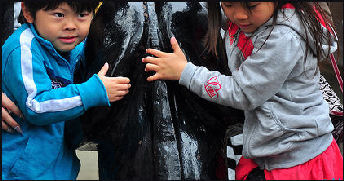
kids at a penis festival
Japanese have traditionally has not linked with sex with guilt, shame and taboos as is the case in with Westerners. Premarital and extramarital sex have never been linked with sin the way they have in Christian and Muslim cultures. Shintoism has no concept of original sin. Sex is regarded as natural urge. Sex outside marriage has traditionally not been frowned upon and in some cases has even been encouraged.
A Japanese psychologist told the Japan Times, "Both traditionally and subconsciously, extra-partner sexual relationships are allowed, as long as men don’t break the official and conscious relationship with the regular partners. Although such behavior might clash with Judeo-Christian moral values, here “uwaki” [infidelity] is distinguished from “honki” [true feelings].
An adult movie film consultant told the Japan Times, "Unlike many sanctimonious people in the West, Japanese seem to accept that humans are sexual and find no guilt catering to these natural desires."
Young People, Love Hotels and Sex in Japan

Mexican love hotel The age for consensual sex in Japan is 13. A survey of 3,200 high school students by Asahikawa Medical College found that 40.3 percent of the girls and 35.8 percent of the boys had had sexual experiences A different survey in 2000, found that around 40 percent of high school senior boys and 33 percent of high school senior girls said they had sex, a threefold increase from a decade earlier. Of these only half said they used contraceptives.
Teenagers are fairly sexually active in Japan but backseat love and hanky panky while the parent are at work or away for the weekend are fairly uncommon. Most young couples go to Love Hotels.
Love hotels are places that rent out rooms by the hour for couple having trysts and men meeting prostitutes. The hotels have names like with names Let’s, Charme, Maitresse, Le Refrain, Valentine Motel, and Eros Motel. Some rooms are bare and sparsely furnished. Other have round beds, mirrored ceilings, special chairs built for activities other than sitting, and racy artwork. Complementary toothbrushes and condoms sit on the bureau. Most have curtained off underground parking lots to keep the identity of guests secret. Because rooms can be rented for $25 an hour, up to five or six times a day, the hotels can be quite profitable.
Lack of Sex in Japan

Inside a love hotel According to sex survey by SSL International PLC, makers of Durex brand condoms, involving people in 28 countries, the Japanese are the least sexually active people, on average having sex only 36 times a year, compared to the world average of 97 times a year.
A survey by WHO, released n March 2008, found that 1 in 4 married couples in Japan had not had sex in the previous year and 37 percent of couples in their 50s no longer had sex. Many blame this on the Japanese obsession with work.
Condom sales and the number of teenage abortions has dropped in recent years. Some attribute the trend to a fascination by teenage boys with virtual girls online. One Japanese public heath official said, “They don’t want to get hurt [by being duped by human girls]. So they never advance past the 2-D world.”
According to a September 2010 government survey answered by 671 men and 869 women one third of Japanese males aged 16 to 19 are uninterested in or even averse to sex, double the figure in 2008. The survey also found that 40 percent of married couples said they had not had sex for the last month. Reasons given for not engaing in sex included reluctance after childborth, a sense that being intimate is a bother and job-related fatigue.
One 44-year-old male sex volunteer told the Japanese writer Sumie Kawakami that a surprising number of women with unhappy or non-existent sex lives visit a “sex clinic” to achieve sexual fulfillment at least once in their lives.
Sex and Art in Japan
Japanese “shunga” ("spring pictures") are sexually-explicit woodblock prints that were popular in the Edo period (1603-1868). Some featured couples in a variety of sexual positions. Others features humorous depictions of men with enormous penises or couples with enlarged genitalia. Some are quite crude. Others are exquisitely done and are regarded as works of art. works Even Japanese famous artists such as Utamaro and Hurunobu made them.
Shunga held a large share of the ukiyo-e market. There are number of theories why they were so popular. Some have suggested it was because they were pornography and nothing more. Some have said they served as trousseaus for brides to prepare for their wedding night. Other have suggested that were an aid for masturbation. Masturbation is not equated with sin and weakness like it os the West. And because of husbands were often separated from the wives due to Edo period laws, masturbation was preferred to infidelity.
Works that look mundane often had a sexual meaning. A swing lantern, a peony or a boa pole all had sexual connotations.
“Nawashibari”, erotic rope binding, was developed in 17th century Japan by samurai who used similar methods to torture criminals.

shunga
Sex on Television in Japan
Exposed breasts, female humiliation, and frank discussions about sexual topics are fixtures of late night Japanese television. Programs after 11:00pm include shows with men in porno shops talking about new video releases (and showing their graphic covers) with embarrassed, giggling young women; movies that blur out the genital areas but show everything else; and game shows filled with close-ups of the breasts and crotch areas of bikini-clad women.
Late night shows that have appeared over the years have included “I'm Sorry For My Nice Body”, featuring bikini-clad girls talking about themselves and their bodies; “Kiss Me in a Bathing Suit”, with women, sometimes in only half a bathing suit, kissing men in front of a hooting and howling audience; and “Look for Big Breasts”, with well-endowed females personalities explaining how they take care of their breasts or how they made them so big. The latter employed reporters who searched around Japan for large-breasted women, who are willing to expose them on national television.
Films with sex and violence and foul language are broadcast uncut during prime time on major networks. Some times sex and cutsiness are mixed. One show feature nude women in a hot spring singing the Mickey Mouse Club song.
Manga and Sex
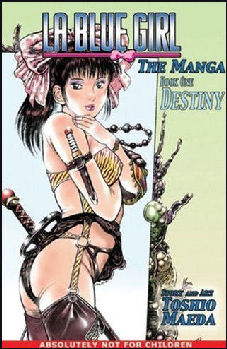
Much of the sex depicted by male artists is heterosexual or “yuri” (“girl on girl”). Much of the sex depicted by female artists is “yaoi” (boy-on-boy). The male figures in the yaoi manga tend by emasculated and non-threatening rather than overtly muscular and masculine. Many yaoi boy look like girls with large eyes, and lithe bodies. The plots tend to be sappier with more emphasis on kissing and romance than sex. The fact that two gay guys are in it give an appealing mystique.
Explicit depictions of sex acts and graphic violence are common features in manga. “Shonen” mangas for boys often feature hands slipping under panties of young girls and savagely violent science fiction and adventure stories. Salarymen comics have wish-fulfilling stories about business who beat up their bosses and have wild sex trips in Thailand. One particularly notorious manga called “Rape-Man” was finally yanked off the racks because of criticism.
"I think Japanese comics in general are a playing out of the subconscious," Schodt told the New York Times. "Maybe they fill a role similar to dreaming. You work out your stress, explore youth fantasies, and then you go back to work and normal life."
Sex Tourism in Japan
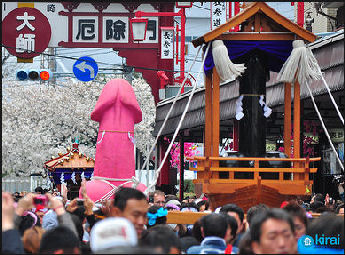
penis festival In the 1980s, jets planes full of Japanese men arrived daily in Thailand and the Philippines on pre-paid sex tours that included plane fare, accommodation, transfers and a local girl waiting for them in their room. The AIDS scare slowed this business.
In September 2003, Japan got a lot of bad press when reports emerged that 380 Japanese businessmen with a construction company running around with 400 Chinese prostitutes in hotel in Zhuhai, China. One of the prostitutes told the Washington Post she was with three of four Japanese men. “They had a big party. On my floor, at least, they had girls in every room.”
The Japanese businessmen arranged to meet prostitutes through a staff member in the hotel’s Japanese marketing department, paying $145 to each woman, according to the Beijing Youth Daily. The incident drew more publicity than it otherwise might of because it occurred on the anniversary of the beginning of the Japanese occupation of Manchuria in 1931. The hotel was closed temporarily. Several hotel workers were arrested and forced to take “emergency study sessions.” And the Japanese government said it was going to investigate.
Some Japanese have been arrested in Cambodia for having sex with children. "This indicates there are still many Japanese tourists who pay to have sex with children in Cambodia," Keiko Saito of ECPAT/Stop Japan told the Yomiuri Shimbun. "The number of tourists arrested [by Japanese police on charges of violating the child prostitution law] is likely just the tip of the iceberg." ECPAT/Stop Japan is an NGO working to prevent the sexual exploitation of children. [Source: Harumi Ozawa, Daily Yomiuri, September 24, 2005]
“In 1996, Japan was taken to task at the world conference on commercial sexual exploitation of children in Stockholm, largely for two reasons: It was believed to be responsible for 80 percent of child pornography circulating on the Internet, and it was the source of a large number of tourists visiting Southeast Asian countries seeking sex with minors. “
“Crimes such as buying sex from minors tend to be hidden from public view, probably more so in regard to such crimes by foreign visitors, and there are no official statistics or estimates available regarding Japanese tourists who pay for sex with children overseas. The National Police Agency does not disclose a figure for Japanese suspects arrested on suspicion of paying for child sex if the crime was committed abroad. The Yomiuri Shimbun has reported at least five cases in which Japanese allegedly paid for sex with minors overseas, the most recent in May. A dozen people arrested or who were sent to prosecutors were suspected of crimes that violated the 1999 law.
See Cambodia
Combating Sex Tourism
Harumi Ozawa wrote in the Daily Yomiuri, “The Japanese tourism industry is finally starting to assist in this effort by making sure its businesses are legitimate and clean. Led by the nation's largest travel agency, JTB Corp., about 60 travel companies and two major industry associations--Japan Association of Travel Agents (JATA) and Overseas Tour Operators Association of Japan--joined a worldwide campaign against the sexual exploitation of children in March. [Source: Harumi Ozawa, Daily Yomiuri, September 24, 2005]
“Partly in response to international pressure, the Japanese government in 1999 passed a law aimed at proscribing child pornography and the commercial sexual exploitation of children. By 2001, when the next conference on this subject was held in Yokohama, there appeared to have been a significant decline in child pornography produced in Japan.
“As of 2005, 81 Japanese companies had joined the Code of Conduct to Protect Children from Sexual Exploitation in Travel and Tourism, making Japan one of the largest participating countries in the campaign. The code was launched in 1998 under the initiative of ECPAT Sweden, with the support of the World Tourism Organization and travel agencies.
“Participating firms, including hotels and airlines, must honor six pledges. These include: 1) Establishing in-house policies and amending company codes of conduct to reflect their positions against the sexual exploitation of children. 2) Training employees stationed both at home and abroad. 3) Including a clause in contracts concluded with local business operators stipulating that both parties will work to prevent the sexual exploitation of children.
Sex Museums in Japan
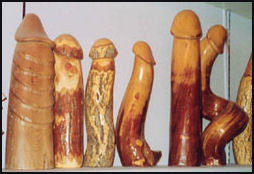
sex museum display There are a number of sex museums in Japan. The Sex Museum in Uwajima on the island of Shikoku is a carefully-researched, three- story museum with all sorts of unmentionable stuff gathered from all over the world by a Japanese anthropologist. Among the more interesting exhibits are an amusing collection of shunga woodprints cartoons with a guy whose penis is much too large for his own good.
Most of the museum is filled with artistic pornographic drawings, painting and statues from Japan and different cultures around the globe. The collection includes a large display of chastity belts from Indonesia and Europe, a huge array of ticklers and women-pleasing devises, Greek vases and Peruvian pottery with erect penises, Kama Sutra illustrations, Tibetan Tantric sculptures. leather S&M equipments, and anatomically-correct images of Pacific fertility gods.
There is also a statue of a king who is surrounded by a dozen women who are all being satisfied at the same time by different parts of the kings of body, and a collection of pubic hair, with over 1000 different samples, each identified with a name and nationality, assembled by a Japanese gynecologist.
The museum isn't too hard to find. Just look for sculpture garden with large wooden and stone phalluses from the South Seas. The atmosphere inside is a little stuffy, and some the animal pictures are pretty disgusting. The museum is linked with a Shinto Shrine across the street.
There are also an S and M museums
Viagra in Japan
When Viagra went on the market in the United States in the summer of 1998, Viagramania hit Japan. The drug was sold illegally at bars and brothels, and from sleazy dealers in Tokyo's red light district. Single pills sold for as much as $400. Doctors in Hawaii, Seattle and San Francisco were busy writing prescriptions for Japanese men who came from Japan with expressed purpose of securing a Viagra supply.
Travel agencies arranged trips to specifically to buy Viagra. Three-day $1,379 Viagra tours to Guam and Hawaii include a doctors exam and two bottles of Viagra. Most of the members of the tour were men in the 50s.
Viagra was approved with a minimum of fuss by the Japanese-equivalent of the FDA in 1998 after a review process that took only six months while birth control pill had been under review for nine years and remained unavailable 34 years after regulatory approval was first requested. Many women felt there was clearly a double standard. It was said that Viagra was approved so quickly because members of Parliament — mostly old men — wanted to get their hands on the drug.
Sex Education in Japan
Yoshiro Hatano, Ph.D. and Tsuguo Shimazaki wrote in the Encyclopedia of Sexuality: There is no distinct sexuality or family-life education course included in the subjects to be taught in the Japanese school system. The Course of Study does not require anything to be taught about sexuality, nor does the national government determine any objectives or the content of sexuality education wherever a local school or teacher decides to deal with this topic at any grade or school level. The official statement provided by the Ministry of Education states that “The contents of education regarding sex (and sexuality) are distributed in various respective subjects (relevant to biology, sociology and health, etc.) and sex (and sexuality education) is certainly expected to be integrated in all these subject matters at each school.” Therefore, the promoters of sex (and sexuality) education, such as those involved in the Japanese Association for Sex Education (J.A.S.E.), have been advocating school instructional programs by developing and publishing Sex Education Guidelines for various school levels and various grades. J.A.S.E. was established and was officially approved by the Ministry of Education in 1972, and has since been the leading nonprofit organization in the field of sex education. [Source: Yoshiro Hatano, Ph.D. and Tsuguo Shimazaki Encyclopedia of Sexuality, 1997 ++]
On the other hand, improvement in education for HIV and AIDS is increasing in Japan’s schools because of the rapid spread of HIV and AIDS throughout the world since the late 1980s. This in turn has strengthened the importance of sex education in the Japanese schools. Since 1992, as a result of revisions in the elementary school Course of Study, childbirth has been introduced into the science textbook, and physical and psychological changes of adolescence into the health education textbook, indicating that some changes can be made in the Course of Study. Any changes in the Course of Study automatically means definite changes in the instructional contents at every school. At present, all upper grade elementary school children are expected to be exposed to the physiological and psychological aspects of human sexuality. However, so far no textbook describes any aspects of sexual intercourse, which has prompted some criticism from classroom teachers about the incomplete vision and unrealistic attitude of the Ministry of Education. ++
In the junior high school level, certain topics in sex education are dealt with in health education, science (biology), social studies, and domestic science. However, these are handled less candidly and actively than in elementary schools in the same system or district. The case is similar as well in the senior high schools; the reason perhaps being that classroom instruction is regarded much less as an education for human living than as a preparation for the next entrance examination, i.e., senior high school for the junior high students, and colleges and universities in the case of senior high school students. ++
“Education indeed is the greatest prevention” is the standpoint of the Ministry of Education regarding HIV and AIDS prevention. Because of this view point, elementary school faculty are strongly encouraged to teach that HIV and AIDS are not transmitted by mosquito bites or by shaking hands with others, and that no person with HIV or AIDS should be discriminated against. It is greatly regretted by many educators and members of J.A.S.E. that sex education in Japanese schools currently needs to be improved so much and that teaching the fact that HIV can be transmitted through sexual intercourse is still not well accepted among the school children. This impacts also on a number of cases in which hemophiliac patients have become HIV-positive because of contaminated blood transfusions. By 1985, about 40 percent of all Japanese hemophiliac patients, more than 2,000 people, had contracted HIV through contaminated imported blood products. As of 1995, hemophiliac patients accounted for 60 percent of Japanese people with HIV. See Section 11 on HIV/AIDS. (Kaji)] Even these patients are hesitant, because of public ignorance, to admit they are HIV-positive. As a matter of fact, voluntary admission of HIV-positive status is almost nonexistent in Japanese society. This is because, for most Japanese people, admitting to being HIV-positive is viewed as a kind of social suicide and societal discrimination is definitely expected. ++
Because of centuries of a national isolation policy that rejected anything that might endanger cultural and religious harmony, a person with any unusual handicap or disease like HIV was commonly treated as an enemy of society, or at least rejected. It is therefore difficult to judge whether appropriate HIV-related education would produce any effects in changing the attitudes of children of any age to HIV-positive persons. [An added problem is the great reluctance, especially among elementary school teachers, to mention, let alone discuss, sexuality in their classrooms (Kaji)]. Even in junior and senior high schools, where one might expect teachers to be more open in dealing with sexual issues, and students to be more open to education about discrimination prevention, the effectiveness of education in reducing discrimination against persons with HIV is unclear. ++
Sex Education Trends in Japan

Sex education is very limited in Japan and was not made part of the curriculum until 1992 when the first health books for fifth graders were issued. There are government guidelines for teaching lessons about sex in health, socials studies and home economic classes but these lessons are rarely taught because many teachers are embarrassed about teaching them. When sex education classes are taught teacher say that girls are more open to talking about sex than boys.
Some sex education classes are quite primitive. In some cases high school students are subjected to lectures where they are shown disgusting pictures of people with sexually transmitted diseases and told that abortion sometime poke hole sin woman’s uterus making it impossible for them to have children.
Many young Japanese are ignorant about birth control use and prevention of sexually-transmitted diseases. They often say what they know about sex they learned from manga (comic books), magazines, videos and Internet sites. Manga aimed for young people is often very explicit and pornographic websites are easy to access. Representatives of the Japan Family Planning Association say, judging from the calls they receive, children who learn about sex from these sources often get distorted information and strange ideas about sex, and thus have urged better sex education in schools.
Hisashi Sekiguchi, a lecturer on sex education at Chiba University told the Yomiuri Shimbun, “Many teenagers don’t have basic knowledge about, for example, the menstrual cycle and how women become pregnant. Young Japanese are very vulnerable compared with their counterparts in other industrialized countries.”
An effort has been made to improve sex education classes with a focus teaching kids in an easygoing atmosphere on protecting oneself against sexually transmitted diseases, avoiding unwanted pregnancies and defending oneself against sexual predators.
In the early years some teaching materials were quite “progressive” and criticized for “promoting casual sex.” In recent years these materials have been toned down or eliminated. According to education-board guidelines teachers are required to use certified curricula and age-appropriate terminology. The guidelines discourage the use of the words “sex” and “sexual intercourse” at all grade levels and say that foreign words like “penis” and “vagina” are not appropriate for describing private parts. On the issue of AIDS prevention the guidelines advises “avoid sexual contact.” In some cases pictures of mating dogs and fish have been left out because they were considered inappropriate.
Supplementary texts for elementary school that show pictures of sexual organs and provide explanations about sexual intercourse and middle school books that explain how to use a condom have been removed.
Content of Sex Education in Japan
Yoshiro Hatano, Ph.D. and Tsuguo Shimazaki wrote in the Encyclopedia of Sexuality: The content of the sex education actually received by students was studied in 1981 and 1987 surveys; Figure 1 shows a breakdown in the content of sexuality education by subject (J.A.S.E. 1988). When these subjects are clustered into three general categories, (1) physiobiological, (2) psychological, and (3) social, the youth surveyed reported that 29.4 percent - three out of every ten - had received no sexual education at all (type 0) while an identical figure of 29.4 percent received an education that covered all three general categories (type III). A little over 20 percent had sexuality education that covered only the physiological and biological aspects (type I), while 13.5 percent and 12.8 percent had instruction that covered the physiological-biological and social (type IIA), or psychological-biological and psychological (type IIB) respectively. The sex education Japanese children do receive is more often limited to the facts of physiology and biology. [Source: Yoshiro Hatano, Ph.D. and Tsuguo Shimazaki Encyclopedia of Sexuality, 1997 ++]
Naturally, the amount of education, particularly that of type III, increases as the level of schooling advances. In addition, it is shown that in junior high school, the psychological aspects of sexuality are emphasized. This may be an understandable trend since the biological and psychological aspects of pubescent events occur just before or in the early stages of adolescence. ++
As mentioned earlier, the contents of sex education in Japanese school systems are more or less centered around physiological aspects and are therefore cognitive-oriented rather than attitudinal-behavior-oriented. In order for sex education in Japanese schools to become the comprehensive sexuality education it needs to be, more consideration must be given to the psychological and sociological aspects of sexuality. HIV and AIDS education and prevention needs to be incorporated in this framework as a well-balanced education within the national Course of Study. ++
Informal Sources of Sex Education
Yoshiro Hatano, Ph.D. and Tsuguo Shimazaki wrote in the Encyclopedia of Sexuality: Teen sex magazines are popular and widely read by Japanese youth. They are noticeably different from their adult counterparts, comparatively wholesome, or at least harmless or insipid. Instead of the violent, sadistic, and degrading content common in adult pornography, teen sex magazines are filled with frivolous, inane, and unabashed boys’ club talk and candid cheerleader squat-shots and near-nudist pictorials. Since true sexuality education is absent from Japanese education, and parents and the community no longer communicate this essential information to youths, these magazines do perform an important function, providing limited but basic information about sexual anatomy. Unfortunately, their popularity depends on adolescent titillation that ignores the need to provide information on STD prevention and contraception. Japanese television is also a major informal source of limited sexual information, particularly in the early evening television cartoon programs that cater to adolescent male curiosities about female anatomy (Bornoff 1991, 71). [Source: Yoshiro Hatano, Ph.D. and Tsuguo Shimazaki Encyclopedia of Sexuality, 1997 ]
Birth Control in Japan
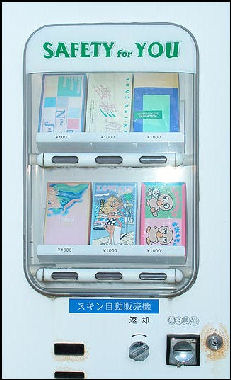
condom vending machine Among Japanese that use birth control, 80 percent use condoms, followed by the rhythm method and spermicide jelly. Some use female contraceptives (a cookie-size, thin piece of plastic with a spermicide). Sterilization is practiced among couples that already have kids. Many Japanese don't use contraceptives as illustrated by the high number of shotgun weddings.
Japanese birth control policy has often been determined by politics. Abortions were banned in 1907 and all kinds of birth control were made illegal in World War II. In the 1950s, when the population was growing rapidly and women were added in the labor force, abortion were legalized for "economic and health" reasons.
Single women are reluctant to visit gynecologists because of the widespread assumption that only reason a single woman would do so would be to obtain an abortion or receive treatment for a sexually transmitted disease. Single women become painfully aware of these assumptions if they are in awaiting room surrounded by pregnant or married women.
Birth Control Pills in Japan
Birth control pills were finally approved in Japan in May 1999, nearly 50 years after they were approved the United States. Before then only high-dose varieties of the pill were available and they were prescribed for menstrual disorders not birth control. These pills carry a higher risk of high blood pressure and some forms of cancer than the low dose versions.
Over the years the Japanese government has supported the ban on the pill on the grounds of sexual morality, AIDS prevention and women's health. Critics have claimed the pill encourages promiscuity, produces side effects such as morning sickness, bloating and strokes and pollutes rivers with hormones. Among the groups opposed to the legalization of birth-control pills were condom makers and health clinics that performed abortions.
One of the main reasons approval of birth control pills was finally granted was the outcry over the fact that Viagra was approved with a minimum of fuss by the Japanese-equivalent of the FDA in 1998 after a review process that took only six months while birth control pill had been under review for nine years and remained unavailable 34 years after regulatory approval was first requested. Many women felt there was clearly a double standard. It was said that Viagra was approved so quickly because members of Parliament — mostly old men — wanted to get their hands on the drug.
Aversion to Birth Control Pills in Japan
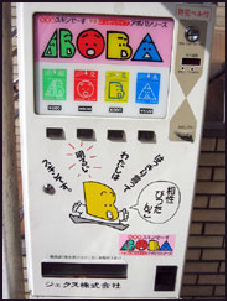
bloody-type condom
vending machine It was thought that after the pill was legalized, Japanese women would jump at the change to take it. That has not happened. As of 2004, five years after they were legalized, Japanese women continue to shun birth control pills. According to one survey only 1.3 percent of the Japanese females between 15 and 49 used the pill, compared to 15.6 percent in the United States. More than 70 percent the women surveyed said they would never use the pill. Only 20 percent said they world try it.
Reasons why Japanese women avoid the pill, experts say, include ignorance, easy-to-obtain abortions, marketing restrictions, discriminatory pricing and taboos associated with visiting a gynecologist. A month’s supply of birth control pills cost around $30 but women who want the pill sometimes have or pay a $1,000 a year for the pills and extensive tests required to get a prescription.
Many women fear they will gain weight, become infertile, or suffer some other side effect. One woman told the Los Angeles Times, "I hear women can't get pregnant again, even after they stop using it." Another said, "It's much cheaper and easier just to ask men to but condoms. Taking something everyday seems like a real bother."
On the social stigmas attached to birth control pills, one Japanese psychiatrist told Newsweek, "Many women still say, my boyfriend would think I play around if I talked about birth control." One Japanese gynecologist said, "It's easier for a Japanese woman to say she's had an abortion that to say she's on the pill."
Condoms in Japan

Condomania shop Condoms are the most common form of birth control. According to a United Nation study, they are used regularly by 46 percent of couples between the ages of 15 and 49 and by 80 percent of the sexually active public who use birth control.
.
One reasons they are so popular is that they are easy to obtain with a minimum of fuss and embarrassment. Condoms are sold at all kinds of stores and can be purchased discreetly from vending machines. Condomania in Tokyo sells Skinless Wrinkle Zero-0 condoms and glodoms" that "light up your love life." Sometimes female salespersons sell them door-to-door in respectable neighborhoods.
Condom use is linked with low teenage pregnancy, low HIV and sexually transmitted disease rates. Widespread use of condoms dates back to World War II when Japanese soldiers in foreign lands were required to use them when the visited prostitutes. Women often insist that men wear condoms and the men comply.
Sex Research and Advanced Education in Japan
Yoshiro Hatano, Ph.D. and Tsuguo Shimazaki wrote in the Encyclopedia of Sexuality: With the exception of such scientific subjects as reproduction and birth taught in the fields of biology or medicine, Japan’s institutions of advanced education have only made sex a direct topic of research in the past two or three decades. Traditionally, sex has not been made a subject of learning in Japan’s academic world. Thus, on the rare occasion that someone has pursued the study of human sexuality, that person has been seen as an outcast, and, at times, ostracized, as was the case with Senji Yamamoto, who taught in the Biology Department of Doshisha University and early in this century was Japan’s first sexologist. [Source: Yoshiro Hatano, Ph.D. and Tsuguo Shimazaki Encyclopedia of Sexuality, 1997 ++]
Although Japan became a democratic society in 1945 allowing for the freedom to study human sexuality, even in institutions of advanced education, a wall remained standing in the academic world inhibiting such freedom, and the wall was high and thick. No reason exists for the academic world to be separated from society. It has become gradually understood that sex education is necessary in higher education in order to address the various problems in Japanese society, such as sexual problems among youth, information on sex provided by the media, the issue of STDs and HIV/AIDS, and the phenomenon of more couples opting to rear fewer children. ++
Universities for training teachers and departments of education were the first to show an interest in teaching sex education at the university level. Regardless of its quality, sex education in Japan’s elementary and junior high schools and institutes of advanced education is usually taken up in the health and science curricula. Therefore, it was natural for sex education to be first taught to those interested in teaching. Recently, an increasing number of departments of human science have been established in Japanese universities, wherein study of basic human sexuality has become abundant. ++
Still, sex education in universities and other institutions of advanced education cannot be said to be functioning sufficiently. Take, for example, the estimate that only about 5 percent of Japan’s 1,150 universities and junior colleges provide lectures on human sexuality. One can assume that developing more programs on sex education in universities and other institutions of advanced education will become a major issue in Japan’s educational system.
Sexological Organizations and Publications in Japan (1997)
Japanese Association for Sex Education. Address: J.A.S.E., Miyata Building, 2F, 1-3 Kanda Jinbo-cho, Chiyoda-ku, Tokyo, 101 Japan. Telephone: +81-3-3291-7726; Fax: +81-3-3291-6238. J.A.S.E publishes, Sex Education Today, a monthly journal. In mid-1996, Tsuguo Shimazaki established the Nikon Information Center for Sexology (NICS). Address: N.I.C.S., Hobunkan Building, 6F, 3-11-4 Kanda-Jinbo-cho, Chiyoda-ku, Tokyo 101 Japan. Telephone: +81-3-3288-5900; Fax: +81-3-3288-5387. N.I.C.S. publishes Sexology Updater (ten times a year).
Other Japanese sexological organizations and publications include: 1) Japanese Association of Sex Educators, Counselors, and Therapists (JASECT), JASE Clinic, 3F Shin-Aoyama Bldg (West), -1 Minami-Aoyama, 1-chome Minato-ku, Tokyo 107 Japan. 2) The Japan Family Planning Association, Inc. (JFPA). Address: Hokenkaikan Bekkann, 1-2, Ichigaya Sadohara-cho, Shinjuku-ku, Tokyo 162 Japan. Telephone: +81-3-3269-4041; Fax: +81-3-3267-2658. JFPA publishes the journal Family Planning and Family Health (monthly). 3) Japan Federation of Sexology (JFS). Address: c/o Nikon Information Center for Sexology (NICS), Hobunkan Building, 6F, 3-11-4, Kanda-Jinbocho, Chiyoda-ku, Tokyo 101 Japan. Telephone: +81-3-3288-5200; Fax: +81-3-3288-5387. 4) Japan Institute for Research in Education, 4-3-6-702 Kozimachi Chiyodaku, Tokyo 7102 Japan. Phone: 03-5295-0856; Fax: 03-5295-0856.
5) Japanese Organization for International Cooperation in Family Planning, Inc. (JOICFP), 1-1, Ichigaya Sadohara-cho, Shhijuku-ku, Tokyo 162 Japan. Phone: 81-3/3268-5875; Fax: 81-3/3235-7090. 6) Japan Society of Adolescentology (JSA). Address: c/o Japan Family Planning Association, Hokenkaikan Bekkann, 1-2, Ichigaya Sadohara-cho, Shinjuku-ku, Tokyo 162 Japan. Telephone: +81-3-3269-4738. JSA publishes the journal Adolescentology (four times a year). 7) The Japanese Society for Impotence Research (JSIR). Address: c/o First Department of Urology, Toho University School of Medicine, 6-11-1, Omori-nishi, Ota-ku, Tokyo 143 Japan. Telephone: +81-3-3762-4151, extension 3605 or 3600. Fax: +81-3-3768-8817. JSIR publishes the Journal of the Japanese Society for Impotence Research. 8) Japanese Society of Sexual Science (JSSS). Address: c/o Hase Clinic, Shin-Aoyama Building, Nishikan 3F, 1-1-1, Minami-Aoyama Minota-ku, Tokyo 107 Japan. Telephone: +81-3-3475-1789. Fax: +81-3-3475-1789. JSSS publishes the journal Japanese Journal of Sexology (semiannually).
References and Suggested Readings - Japan
Asayama, Shinichi. 1979. “Sexuality of the Japanese Youth: Its Current Status and the Future Prospects.” Sex Education Today, 36, 8-16 (in Japanese). Benedict, Ruth. 1954. The Chrysanthemum and the Sword - Patterns of Japanese Culture. Charles E. Tuttle Co. Bornoff, Nicholas. 1991. Pink Samurai: Love, Marriage and Sex in Contemporary Japan. New York: Pocket Books. Earhart, H. Byron. 1984. Religions of Japan. New York: Harper and Row. Hatano, Yoshiro. 1972. “L. A. Kirkendall: His Platform for Sex Education and Its Background.” Bulletin of Tokyo Gakugei University, 24(5), 164-77 (in Japanese).
Hatano, Yoshiro. 1988. “Sexualerziehung von Kindern und Jugendlichen in Japan.” In N. Eicher, et al., eds. Praktische Sexual Medizin, Verlag Medical Tribune, pp. 34-42. (in German) Hatano, Yoshiro. 1991a. “Changes in the Sexual Activities of Japanese Youth.” Journal of Sex Education and Therapy, 17(1), 1-14. Hatano, Yoshiro. 1991b. “Education for Parenting Viewed from Education of Sexuality.” In: Japanese Ministry of Education, ed., National Woman’s Education Center. Hatano, Yoshiro. 1991c. “Child-Socialization and ‘Parenting’ Education.” In: International Seminar on Family Education Proceedings, pp. 272-92. Hatano, Yoshiro. 1993. “Sexual Activities of Japanese Youth. Journal of Sex Education and Therapy, 19(2), 131-44. Hatano, Yoshiro, and R. Fujita. 1976. “Sexual Behavior of Selected College and Vocational School Students in Tokyo.” Bulletin of Tokyo Gakugei University, 28(5), 262-72 (in Japanese). Itoi, Kay, and Bill Powell. 1992 (August 10). “Take aHike, Hiroshi.” Newsweek. 38-39.
Japanese Association for Sex Education (J.A.S.E.), ed. 1975. Sexual Behavior of Japanese Youth. Tokyo: Shogakukan Press (in Japanese). Japanese Association for Sex Education (J.A.S.E.), ed. 1983. Sexual Behavior of Japanese Youth. Tokyo: Shogakukan Press (in Japanese). Japanese Association for Sex Education (J.A.S.E.), ed. 1988. Sexual Behavior of Junior High School, Senior High School and University Students in Japan. Tokyo: Shogakukan Press (in Japanese). Japanese Association for Sex Education (J.A.S.E.), ed. 1994. Sexual Behavior of Junior High School, Senior High School and University Students in Japan. Tokyo: Shogakukan Press (in Japanese). Kristof, Nicholas D. 1995 (November 5). “In Japan, Brutal Comics for Women.” The New York Times, Section 4, pp. 1 and 6. Kristof, Nicholas D. 1996a (February 11). “Who Needs Love? In Japan, Many Couples Don’t.” The New York Times, pp. 1 and 12. Kristof, Nicholas D. 1996b (June 19). “Japan Is a Woman’s World Once the Front Door Is Shut.” The New York Times, pp. A1 and A8. Kristof, Nicholas D. 1996c (October 6). “Baby May Make Three, but in Japan That’s Not Enough.” The New York Times, p. 3. Lester, Robert C. 1987. Buddhism. New York: Harper and Row. Lewin, Tamar. 1995 (May 30). “Family Decay Global, Study Says.” The New York Times. p. A5.
More Report on Female Sexuality. 1983. Tokyo: Shueisha. More Report on Male Sexuality. 1984. Tokyo: Shueisha. National Survey of Sexology and College Education. 1995. Sexual Science, 4(1):27-68. Shimazaki, T. 1994-95. Upon Completing the Fourth Youth Sexual Behavior Investigation. Monthly Report Sex Education Today, 1994, 12, 9-12, and 1995, 13, 1-3. Tokyo: The Japanese Association for Sex Education (in Japanese). Tanikawa, Miki. 1996 (September 8). “Clubs Where, for a Price, Japanese Men Are Nice to Women,” The New York Times, Styles Section, p. 49. Wolferen, Karel Van. 1989. The Enigma of Japanese Power. New York: Macmillan. WuDunn, S. 1996 (November 27). “Japan May Approve the Pill, but Women May Not.” The New York Times, p. A1, A10. WuDunn, S. 1996 (January 25). “At Japanese Temples, a Mourning Ritual for Abortions. The New York Times, p. A1 and A8. Yanagihashi, Akitoshi. 1995. “Traditional Homosexuality in Japan.” OCCUR (Association for the Lesbian and Gay Movement). A paper submitted to the 12th World Congress of Sexology, Yokohama, Japan.
Image Sources: 1) Amazon, 2), 6). 9) 10), 13), Japan Visitor, 3) Tokyo Pictures, 4), 8) 14, Hector Garcia, 5) Ray Kinnane. 7) British Museum. 11), 12) Photomann
Hentai Wiki Commons
Text Sources: New York Times, Washington Post, Los Angeles Times, Daily Yomiuri, Times of London, Japan National Tourist Organization (JNTO), National Geographic, The New Yorker, Time, Newsweek, Reuters, AP, Lonely Planet Guides, Compton’s Encyclopedia and various books and other publications.
Last updated January 2014
